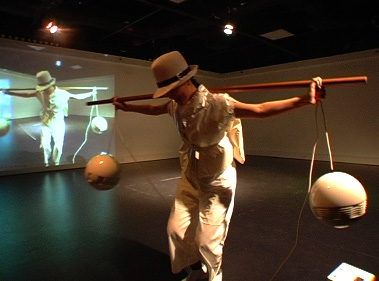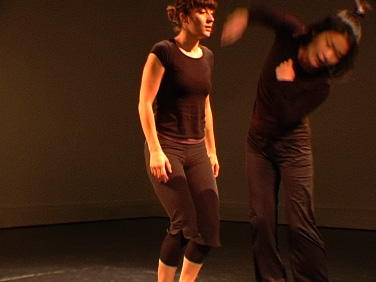Design And Performance Lab
|
UKIYO (Moveable World)
video stills by Olalla Lemus & Johannes Birringer
Project directors: Johannes Birringer & Michèle Danjoux Brunel University, West London
|
Design And Performance Lab
UKIYO
(Moveable World)
.

video stills by Olalla Lemus & Johannes Birringer
UKIYO BLOG
DAP Lab Session on Sundy, October 25, 2009 // DAP Lab Session on Sundy, November 22 , 2009
PHASE II start up
UKIYO - Floating World of impermanence and ephemeral pleasures. UKIYO is a world of opposites - "the urge to be up-to-date and the schizophrenic impulse to draw in and reject at the same time." Gian Carlo Calza (2005), Visions of the Floating World, Phaidon Press, London.
Present at Lab/Participants
Dancers/Performers: Anne-Laure Misme, Caroline Wilkins (musician & instrumental vocalist), Helenna Ren, Katsura Isobe, Olu Taiwo
Musician/composer: Oded Ben-Tal // Choreographer & Filmmaker: Johannes Birringer // Designer: Michele Danjoux // Visitors: Jennifer McColl, Olalla Perez-Hervada Lemus
Reflections on UKIYO phase 1 (after film screening)
Visual colour, texture and abstract expression of characters are strong. Characters are established well through design characteristics and initial sequences of movement and sound. Relationships between characters (once initial character is shaped) not so clearly developed or defined when we move from solo to overlapping performances (duo, trio). There is scope for development in this area. Caroline Wilkins suggests that this could be done through sound and voice - "sound theatre". A form of call and response - perhaps a live processing, mental recording and replaying transformed (by new voice and new breath). This could for instance lead to an accumulation (choral) of sound in the second half of the performance/installation - and this is also the Part in which the realities are mixed more and more (real and virtual, first and second lives). Johannes suggests that perhaps in order to enjoy the exploration of sound, amount of screen images needs to be reduced, careful relationships (that are meaningful) between choreographic gesture, kinaesonic gesture, and projected images.
Building up relationships of sound, shifting sounds from one performer to another and to the space: Helenna, Caroline, Katsura, Anne-Laure (and Yiorgos) working with voice and gesture and movement in a form of sound-movement response. Experimenting with different and opposite characteristics and emotional responses; "indifference/intrigue"
This approach of relating to others helps us to define ourselves (Olu Taiwo).
How the (sonic) characters create acoustically then becomes central to the questioning of the fashion designer working in such a context within the audiophonic dimension.
The dialogue between characters in performance then is of key concern; also of key concern is the dialogue with the audience. Here we can consider the audience as collective and as individual, leading almost to the one on one perspective, the one to one also being part of a larger collective where everyone recognizes everyone sharing the same space.
.
.
Testing the new audiophincs construction for Speakerwoman, October 25, 2009, with Michèle Danjoux, Oded Ben-Tal, and Helenna Ren (right), Speakerwoman interface with GestureDance (Schlemmer)
Reflections on Opiyo Okach - " Shift - centre" (Kenya & France, 2009)
now touring the UK. Dance Umbrella 2009, The Place, London 23rd & 24th October 2009.
preview video of "shift... centre"
Opiyo Okach's dance installation ("promenade performance") explores "corporeality of crossed space" and "the fabric of cross cultural space as a framework for choreographic enquiry."
For more information on Okach and the Kenya-based company, go to their website.
This kind of approach to process and to the process of enquiry is of great interest to me as a fashion designer working within a performative context. As I contemplate my designs being an example and outcome of a philosophical process as well as a physical engagement with dynamic and shifting bodies, I see this to lead to core concerns of embodiment of both design and process and also issues of practice as research and semiotics of conceptual design (external sources of information - i.e. sound emitting garments/accessories and styling).
Experiencing Opiyo Okach - "Shift-centre" (if one compares its dramaturgical and scenographic design, for example, with kondition pluriel' s installation "passage" -- bibl.html ; look under reviews) lead me to consider more fully the notions of proximity and distance within a performance space. On the one hand we can have the close up and intimate personal experience where we can see and feel the droplets of sweat. On the other we have the touching through membranes (transparent screens) and the viewing/listening from a vantage point somewhere over the other side of the theatre space. I like both these sensations and consider how sonically they could work and be experienced further through garment design (in the space/worn on performers' bodies). One could work with miniature sound only audible to a local few but then at the same time one could offer deep and resonating visceral sound that resonates the space.
I experienced this a little working alongside the sonic group (musicians) "Liquid Penguin" when I visited Interaktionslabor in July this year. Liquid Penguin explored the notions of the small and the big sound and sound that related acoustically to the space - a large abandoned coal mine. The large sound came from speakers in the basement/bowels of the building, flooding up through holes in the floor of the derelict building. The small sound came from an intimate and linear arrangement of tiny speakers on the wall (first floor). One had to be quiet and move close to sense and to hear, also perceiving how the sounding words of the recording moved on multiple channels, from small speaker to small speaker. (http://dancetech.ning.com/video/auf-der-anderen-seite-des) This movement towards and of being close up inspires me a great deal as I think of the erotics of wearing of the textures and details we can experience when we are close.
There are many possibilities of working with sound and garment:
// The sound of cloth - cloth chosen for its sound emitting/sound texture qualities.
// Integration of speakers - wired and carrying the physical and aesthetic burden of the technology.
// Wireless speakers & wireless sensor
//Flat speakers.
// Sensors integrated into garment, gesture and data to drive audio in the soundscape.
// Dysfunctional speakers or audio accoutrements
We can also consider the synaesthesic aspect of the visual and of the sound and tactility of garments and textures here. In the 60's artists explored the notion of a noisy painting through lively and dynamic uses of forms, colours and compositional arrangements (artists names?). The Daniel Brown / Nick Ryan 2006 collaboration featured in the current "Fashion Revolutions" exhibition at Somerset House, London features this work. A jacket explored for the sound of the cloth, part of "SHOWstudio.com's ongoing investigation into re-thinking conventional forms of communicating and describing fashion."
Establishing a new aesthetic:
Infusing garment and cloth with emotive potential and exploring the symbolic potential of abstract colouration and shape/object (e.g. spherical speakers).
Looking back at the old aesthetics of the 1960's "Cybernetic Body" explorations; the "Extensions of Man" and "Communicating Clothing."
Pavitt, J., (2008). "Fear and Fashion - in the Cold War." V&A Publishing, London.
.

sound-theatre rehersal October 25, 2009, with Caroline Wilkins, Katsura Isobe, Helenna Ren and Anne-Lure Misme
Design Concepts for the new UKIYO collection to date:
Red - sounding cloth (sound amplificat-on through the digital)
Black - dysfunctional speakers (dark, gritty sound association)
White - Spherical speaker (suspended sound)
Golden - Bandoneon/Instrument-woman (Julie Bokowiec / kinaesonics)
danjouxblog
27. 10. 2009 Michele Danjoux
(logistics additions by JB)
Further Writings:
This research project is funded by a PM12 Connect/British Council Grant and a RDF (Brunel University) grant.
dance tech network site of Ukiyo project
All photos (c) DAP-Lab
Project directors: Johannes Birringer & Michèle Danjoux
Brunel University, West London